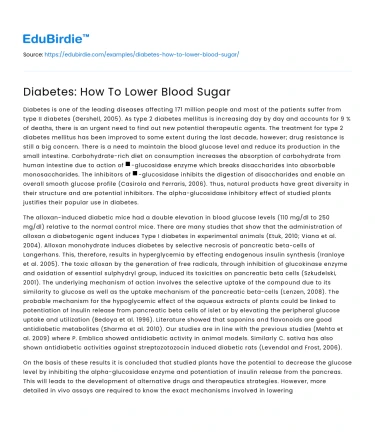Diabetes is one of the leading diseases affecting 171 million people and most of the patients suffer from type II diabetes (Gershell, 2005). As type 2 diabetes mellitus is increasing day by day and accounts for 9 % of deaths, there is an urgent need to find out new potential therapeutic agents. The treatment for type 2 diabetes mellitus has been improved to some extent during the last decade, however; drug resistance is still a big concern. There is a need to maintain the blood glucose level and reduce its production in the small intestine. Carbohydrate-rich diet on consumption increases the absorption of carbohydrate from human intestine due to action of α-glucosidase enzyme which breaks disaccharides into absorbable monosaccharides. The inhibitors of α-glucosidase inhibits the digestion of disaccharides and enable an overall smooth glucose profile (Casirola and Ferraris, 2006). Thus, natural products have great diversity in their structure and are potential inhibitors. The alpha-glucosidase inhibitory effect of studied plants justifies their popular use in diabetes.
The alloxan-induced diabetic mice had a double elevation in blood glucose levels (110 mg/dl to 250 mg/dl) relative to the normal control mice. There are many studies that show that the administration of alloxan a diabetogenic agent induces Type I diabetes in experimental animals (Etuk, 2010; Viana et al. 2004). Alloxan monohydrate induces diabetes by selective necrosis of pancreatic beta-cells of Langerhans. This, therefore, results in hyperglycemia by effecting endogenous insulin synthesis (Iranloye et al. 2005). The toxic alloxan by the generation of free radicals, through inhibition of glucokinase enzyme and oxidation of essential sulphydryl group, induced its toxicities on pancreatic beta cells (Szkudelski, 2001). The underlying mechanism of action involves the selective uptake of the compound due to its similarity to glucose as well as the uptake mechanism of the pancreatic beta-cells (Lenzen, 2008). The probable mechanism for the hypoglycemic effect of the aqueous extracts of plants could be linked to potentiation of insulin release from pancreatic beta cells of islet or by elevating the peripheral glucose uptake and utilization (Bedoya et al. 1996). Literature showed that saponins and flavonoids are good antidiabetic metabolites (Sharma et al. 2010). Our studies are in line with the previous studies (Mehta et al. 2009) where P. Emblica showed antidiabetic activity in animal models. Similarly C. sativa has also shown antidiabetic activities against streptozotozocin induced diabetic rats (Levendal and Frost, 2006).
Save your time!
We can take care of your essay
- Proper editing and formatting
- Free revision, title page, and bibliography
- Flexible prices and money-back guarantee
On the basis of these results it is concluded that studied plants have the potential to decrease the glucose level by inhibiting the alpha-glucosidase enzyme and potentiation of insulin release from the pancreas. This will leads to the development of alternative drugs and therapeutics strategies. However, more detailed in vivo assays are required to know the exact mechanisms involved in lowering the glucose level.
Did you like this example?
Make sure you submit a unique essay
Our writers will provide you with an essay sample written from scratch: any topic, any deadline, any instructions.
Cite this paper
-
APA
-
MLA
-
Harvard
-
Vancouver
Diabetes: How To Lower Blood Sugar.
(2021, August 13). Edubirdie. Retrieved December 22, 2024, from https://edubirdie.com/examples/diabetes-how-to-lower-blood-sugar/
“Diabetes: How To Lower Blood Sugar.” Edubirdie, 13 Aug. 2021, edubirdie.com/examples/diabetes-how-to-lower-blood-sugar/
Diabetes: How To Lower Blood Sugar. [online].
Available at: <https://edubirdie.com/examples/diabetes-how-to-lower-blood-sugar/> [Accessed 22 Dec. 2024].
Diabetes: How To Lower Blood Sugar [Internet]. Edubirdie.
2021 Aug 13 [cited 2024 Dec 22].
Available from: https://edubirdie.com/examples/diabetes-how-to-lower-blood-sugar/
copy






 Stuck on your essay?
Stuck on your essay?

